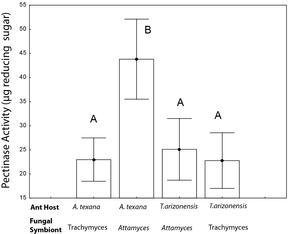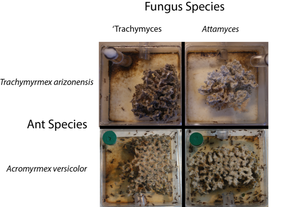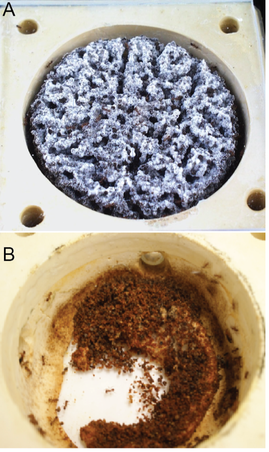One of the central issues facing the study of symbiosis is elucidating how symbioses are organized and function, especially with regard to the mechanisms that maintain specificity and homeostasis between hosts and microbial symbionts. Fungus-gardening (attine) ants form an obligate macrosymbiosis with specific fungi that the ants grow for food. These ants and fungi also form symbioses with a multitude of bacterial and other microfungal species. The attine symbiosis is an excellent model to address functional relationships because the ants and fungi can be experimentally disassembled and reassembled into novel combinations. Previous models that emphasized vertical transmission of ants, fungus and microbiomes in the higher fungus gardening ants, do not explain recently discovered horizontal exchange of fungal symbionts. Through the use of experimentation ('cross-fostering' experiments) we have discovered that ant-fungal pairings differ visibly, physiologically and may exhibit temporal instability (Seal and Tschinkel 2007, Seal et al 2012, Seal and Mueller 2014, Seal et al. 2014, DeMilto et al. 2017). These results suggest that interactions among the macro- and microorganisms promote stability and homeostasis in this symbiosis.
Selected References
DeMilto, A.M., Rouquette, M., Jr., Mueller, U.G., Kellner, K., Seal, J.N., 2017. Effects of substrate, ant and fungal species on plant fiber degradation in a fungus-gardening ant symbiosis. Journal of Insect Physiology 98, 301-308.
Seal, J.N., Gus, J., Mueller, U.G., 2012. Fungus-gardening ants prefer native fungal species: Do ants control their crops? Behavioral Ecology 23, 1250-1256.
Seal, J.N., Mueller, U.G., 2014. Instability of novel ant-fungal associations suggest that microbial interactions constrain horizontal transfer in higher fungus-gardening ants. Evolutionary Ecology 28, 157-176.
Seal, J.N., Schiøtt, M., Mueller, U.G., 2014. Ant-fungal species combinations engineer physiological activity of fungus gardens. Journal of Experimental Biology 217, 2540-2547.
Seal, J.N., Tschinkel, W.R., 2007. Co-evolution and the superorganism: switching cultivars does not alter the performance of fungus-gardening ant colonies. Functional Ecology 21, 988-997.
Seal, J.N., Tschinkel, W.R., 2007. Complexity in an obligate mutualism: do fungus-gardening ants know what makes their garden grow? Behavioral Ecology Sociobiology 61, 1151-1160.
Seal, J.N., Tschinkel, W.R., 2008. Food limitation in the fungus-gardening ant, Trachymyrmex septentrionalis. Ecological Entomology 33, 597-607.
Selected References
DeMilto, A.M., Rouquette, M., Jr., Mueller, U.G., Kellner, K., Seal, J.N., 2017. Effects of substrate, ant and fungal species on plant fiber degradation in a fungus-gardening ant symbiosis. Journal of Insect Physiology 98, 301-308.
Seal, J.N., Gus, J., Mueller, U.G., 2012. Fungus-gardening ants prefer native fungal species: Do ants control their crops? Behavioral Ecology 23, 1250-1256.
Seal, J.N., Mueller, U.G., 2014. Instability of novel ant-fungal associations suggest that microbial interactions constrain horizontal transfer in higher fungus-gardening ants. Evolutionary Ecology 28, 157-176.
Seal, J.N., Schiøtt, M., Mueller, U.G., 2014. Ant-fungal species combinations engineer physiological activity of fungus gardens. Journal of Experimental Biology 217, 2540-2547.
Seal, J.N., Tschinkel, W.R., 2007. Co-evolution and the superorganism: switching cultivars does not alter the performance of fungus-gardening ant colonies. Functional Ecology 21, 988-997.
Seal, J.N., Tschinkel, W.R., 2007. Complexity in an obligate mutualism: do fungus-gardening ants know what makes their garden grow? Behavioral Ecology Sociobiology 61, 1151-1160.
Seal, J.N., Tschinkel, W.R., 2008. Food limitation in the fungus-gardening ant, Trachymyrmex septentrionalis. Ecological Entomology 33, 597-607.


